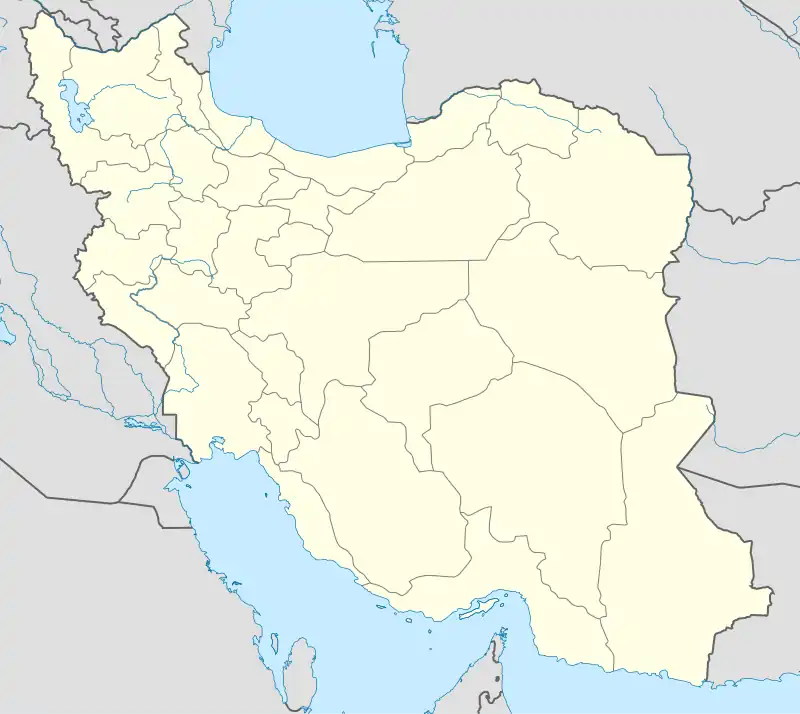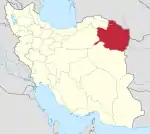Qadamgah
Persian: قدمگاه | |
|---|---|
City | |
.jpg.webp) | |
 Qadamgah | |
| Coordinates: 36°06′22″N 59°03′39″E / 36.10611°N 59.06083°E[1] | |
| Country | |
| Province | Razavi Khorasan |
| County | Zeberkhan |
| District | Central |
| Population (2016)[2] | |
| • Total | 3,010 |
| Time zone | UTC+3:30 (IRST) |
| Qadamgah at GEOnet Names Server | |
_in_Qadamgah_(4460139974).jpg.webp)
.jpg.webp)
Qadamgah (Persian: قدمگاه, also Romanized as Qadamgāh)[3] is a city in the Central District of Zeberkhan County, Razavi Khorasan province, Iran,[4] serving as capital of the county as wll as the administrative center for Zeberkhan Rural District.[5]
At the 2006 census, its population was 2,769 in 797 households, when it was in the former Zeberkhan District of Nishapur County.[6] The following census in 2011 counted 2,958 people in 940 households.[7] The latest census in 2016 showed a population of 3,127 people in 992 households.[2]
After the census, Zeberkhan District was separated from Nishapur County in the establishment of Zeberkhan County, which was divided into two districts of two rural districts each, with Qadamgah as its capital and only city.[4]
History
Qadamgah is a Shia pilgrimage. It is historically part of the Greater Region of the city of Nishapur. It is now legally a separated county (shahrestan) though its people have daily commute and close ties and relatives with the main bigger city of Nishapur which is geographically close to it. Qadamgah used to be a part of the administrative county of Nishapur.
As a result of Imam al-Rida (a.s)'s travel from Medina to Merv, in which he crossed a major part of Iran, there are many qadamgahs attributed to him. The best known qadamgah attributed to the ali al rida (a.s) is the one in Nishapur which was constructed at the command of Shah 'Abbas in 1020/1611 over the relics of another building. It is widely believed that there is a human footprint on a black stone installed inside the building which is attributed to Imam al-Rida (a).
The majority of qadamgah attributed to Imam al-Rida (a.s) in Iran date back to the Safavid era. At least one-tenth of the 250 qadamgahs in Iran which are attributed to a prophet, an Imam, or a holy person are attributed to Imam al-Rida (a.s). The majority of qadamgahs attributed to him are located on his way from Medina to Merv (the so-called "Path of Wilaya").
However, there are qadamgahs attributed to him in other parts of Iran as well.
References
- ↑ OpenStreetMap contributors (11 May 2023). "Qadamgah, Zeberkhan County" (Map). OpenStreetMap. Retrieved 11 May 2023.
- 1 2 "Census of the Islamic Republic of Iran, 1395 (2016)". AMAR (in Persian). The Statistical Center of Iran. p. 09. Archived from the original (Excel) on 2 April 2022. Retrieved 19 December 2022.
- ↑ Qadamgah can be found at GEOnet Names Server, at this link, by opening the Advanced Search box, entering "-3078690" in the "Unique Feature Id" form, and clicking on "Search Database".
- 1 2 Jahangiri, Ishaq (21 February 2019). "Approval letter regarding the establishment of Heshmatiyeh Rural District in Zeberkhan District of Nishapur County, Razavi Khorasan province". Qavanin (in Persian). Ministry of Interior, Board of Ministers. Archived from the original on 2 November 2020. Retrieved 11 May 2023.
- ↑ Mousavi, Mirhossein. "Creation and establishment of 15 rural districts including villages, farms and places in Nishapur County under Khorasan province". Islamic Parliament Research Center. Ministry of Interior, Board of Ministers. Archived from the original on 17 November 2015. Retrieved 3 January 2024.
- ↑ "Census of the Islamic Republic of Iran, 1385 (2006)". AMAR (in Persian). The Statistical Center of Iran. p. 09. Archived from the original (Excel) on 20 September 2011. Retrieved 25 September 2022.
- ↑ "Census of the Islamic Republic of Iran, 1390 (2011)". Syracuse University (in Persian). The Statistical Center of Iran. p. 09. Archived from the original (Excel) on 20 January 2023. Retrieved 19 December 2022.
